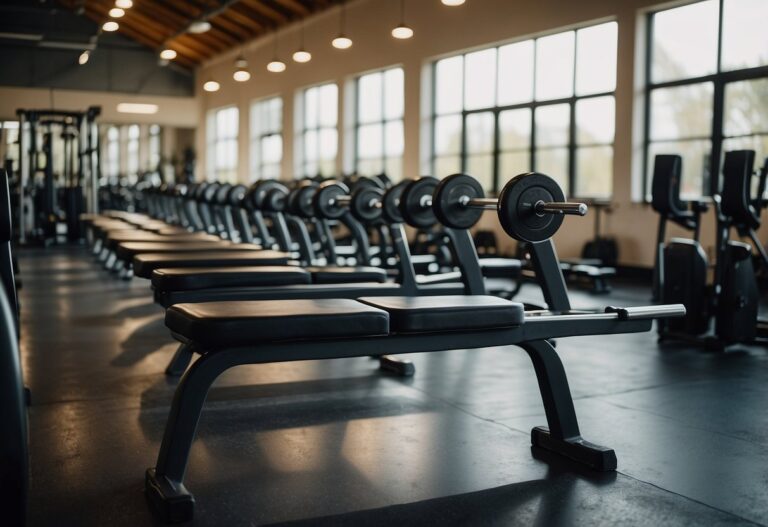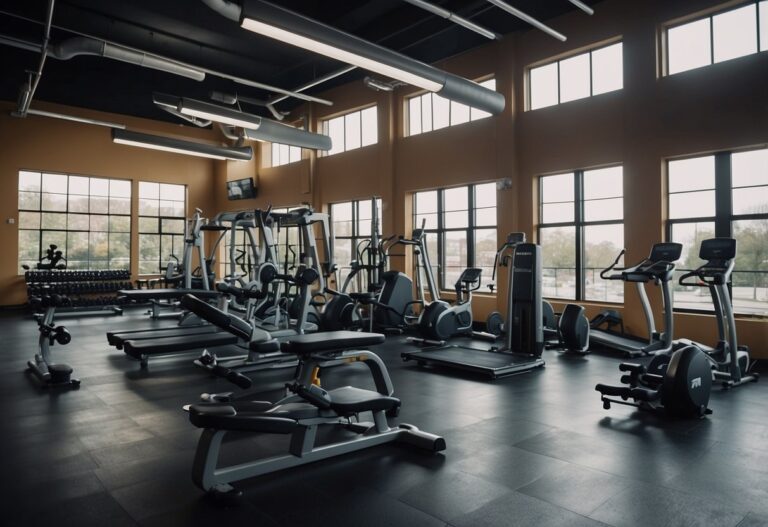When it comes to getting fit and staying healthy, elliptical workouts are an excellent option for many people. These machines offer a low-impact way to boost your cardiovascular fitness while also engaging various muscle groups. Whether you are a beginner or looking to enhance your routine, the right approach can make a big difference in your results.

What are the best tips for making your elliptical workout more effective and enjoyable? Understanding the benefits and techniques of elliptical training can help you make the most of your time on the machine. By following some essential guidelines, you can transform your workout into a more productive and rewarding experience.
Monitor Your Heart Rate
Keeping an eye on your heart rate during an elliptical workout is crucial. It helps you know how hard you’re exercising and can keep you within a safe and effective range.
Begin by entering your weight, age, and target heart rate into your elliptical machine. This ensures the settings are tailored to you. Many ellipticals will then adjust resistance to keep your heart rate in the target zone.
When your heart rate is too high, the machine lowers the resistance. If your heart rate drops, the resistance increases to keep you on track. This is similar to how most treadmills work.
Use a heart rate monitor if your elliptical doesn’t have a built-in one. These devices can be worn on your wrist or chest and sync with many fitness machines. This way, you get real-time feedback on your workout intensity.
Aim to exercise within 70% to 80% of your maximum heart rate for moderate intensity. For higher intensity, aim for 80% to 90%. It’s essential to stay within these ranges to avoid overexertion.
Remember, good posture helps too. Standing up straight and engaging your core can improve your workout efficiency and help you maintain a steady heart rate.
For more information, visit this guide on heart rate control.
Mix Up Intensities
When using an elliptical, try varying your workout intensities. Start with a warm-up on a low level for a few minutes. This helps your body get prepared.
High-intensity intervals can be great for burning extra calories. Sprint for one minute, then recover for two minutes. Repeat this a few times.
Lower intensity sessions might be better if you’re just starting out or need an easier day. These help build endurance and are less tiring.
Keep your body guessing by changing resistance levels and paces. This keeps your workout exciting and effective.
Incorporate Interval Training
Adding interval training to your elliptical routine can boost its effectiveness. By alternating between high-intensity bursts and lower-intensity recovery periods, you maximise calorie burn and improve cardiovascular fitness.
Start with a warm-up to get your muscles ready. Spend about 5-10 minutes on light cardio.
Then, push yourself with intense efforts. Aim for 30-60 seconds of high intensity, where you work as hard as you can. Follow this with 30-60 seconds of active recovery, maintaining a slower, steady pace.
Repeat this cycle for about 10-20 minutes. This combination challenges your body and prevents boredom. It keeps your workouts engaging and productive.
Using interval training, you can effectively and efficiently achieve fitness goals.
For more detailed guidance on structuring your intervals, you might find this comprehensive guide on mastering HIIT on the elliptical helpful.
Focus on Form and Posture
Keep your head up and shoulders rolled back. This will help you maintain a straight spine and reduce the chance of back strain.
Engage your core muscles by keeping your stomach tight. This also helps support your back and improve stability during your workout.
Always keep your knees slightly bent. This prevents knee strain and allows a more fluid motion.
Make sure your feet are flat on the pedals. This distributes your weight and avoids putting too much pressure on your toes.
Use the Handrails Sparingly

When using an elliptical, it’s tempting to grip the handrails tightly. Doing this can reduce the effectiveness of your workout.
Handrails are there for balance, not to support your body weight. If you lean on them too much, you might not engage your core or legs fully, reducing the benefits of your session.
Next time you’re on the elliptical, try to keep a light hold or let go altogether. This encourages better posture and a more effective workout.
Track Your Metrics
Tracking your metrics can make a big difference in your elliptical workouts. Start by monitoring your heart rate and calories burned. These figures give you a clear idea of how hard your body is working.
Most fitness trackers pair easily with elliptical machines. If yours does, take advantage of it. Keep an eye on workout duration and perceived exertion to help ensure you’re making the most of your time.
Consider using additional metrics if your tracker allows. For instance, some trackers measure steps or strides. This information can help you adjust your workout for better results. You can find more tips on boosting your fitness tracker’s accuracy on ellipticals here.
Remember, keeping track of how you feel during and after workouts is crucial. Are you getting stronger or more tired? Listening to your body helps tailor your routine to your needs. Check out how self-awareness enhances your workout here.
Tracking your progress keeps you motivated and informed. It’s like having a coach beside you during every session.
Adjust the Resistance
Adjusting the resistance on your elliptical can make a big difference in your workout. If you’re aiming for a tough session, increase the resistance to push your muscles harder. This can help build strength and endurance.
On the other hand, if you’re just starting out or need a lighter workout, lowering the resistance can keep things manageable. This helps you stay in control and avoid any unnecessary strain.
To keep things interesting, try changing the resistance at different points during your workout. This can simulate the feeling of going uphill and downhill, making your session more dynamic and challenging.
Include a Proper Warm-Up
Before you jump on the elliptical, take a few minutes to warm up your body. Warming up is crucial for preparing your muscles and increasing blood flow. Start with some dynamic stretches to loosen up your joints. This can include leg swings, arm circles, and torso twists.
Follow this with a few minutes of light cardio. You could walk briskly or do some gentle jogging. This will help raise your heart rate and get your blood pumping, setting you up for a more effective workout on the elliptical.
Remember, warming up reduces the risk of injury and can make your exercise session more enjoyable. Take it from personal experience: skipping the warm-up often leads to soreness and less efficient workouts. So, make sure you always include this important step.
Perfect Your Stride Length
Choosing the right stride length on your elliptical can make a big difference. For those of you who are 5’4” and under, aim for a stride length between 11” to 16”. It helps you maintain a natural and comfortable movement.
If you’re between 5’5” and 5’10”, look for a stride length of 16” to 20”. This range suits many people and helps to ensure a good workout.
Taller users, especially if you are 5’11” and up, should opt for a stride length of 20” or more. This allows you to stretch out fully and avoid any discomfort. Perfecting your stride length ensures your workouts are both effective and comfortable.
For more information on ideal stride lengths, check out different stride length recommendations.
Stay Hydrated
When you’re working out on an elliptical, staying hydrated is crucial. Drinking water helps maintain your energy levels and keeps your muscles functioning properly. It’s easy to forget to drink, especially when you’re in the zone.
Keep a water bottle within reach while you’re on the machine. Take small sips throughout your workout to stay hydrated without feeling too full. Remember, even mild dehydration can reduce your performance and make you feel more tired.
Consider adding some electrolytes to your water if you’re sweating a lot. This can help replenish salts lost through sweat, keeping you energised and balanced.
Benefits of Elliptical Workouts
Elliptical workouts offer numerous benefits, making them a popular choice for fitness enthusiasts. These benefits include improving cardiovascular health, aiding weight management, and providing a low-impact exercise option.
Cardiovascular Health
Working out on an elliptical machine is great for your heart. It strengthens your heart and improves blood circulation. By increasing your heart rate, you help your heart pump more efficiently.
Elliptical workouts involve using both your arms and legs, which increases the intensity and makes your heart work harder. This can lead to boosting your stamina and cardio capacity.
Regular use of the elliptical can lower your risk of heart disease. It can also help regulate blood pressure. Consistent cardio exercise is key to keeping your heart healthy.
Weight Management
If you’re looking to manage your weight, the elliptical can be a valuable tool. A 30-minute session can burn a significant number of calories. According to a study, you might burn between 278 to 350 calories, depending on factors like your weight and workout intensity.
This calorie-burning potential makes it easier to create a calorie deficit, essential for losing weight. Additionally, varying resistance and speed can make workouts more effective.
Incorporating elliptical workouts into your routine can complement other exercises and a balanced diet. The ability to adjust settings means you can tailor workouts to your fitness level.
Low-Impact Exercise
Using an elliptical is gentle on your joints. This makes it suitable for all fitness levels, including beginners and those with joint issues. Unlike running, which can be hard on your knees, hips, and ankles, elliptical workouts reduce stress on these areas.
Ellipticals provide a smooth, gliding motion that minimises impact. This is especially beneficial for those recovering from injuries or managing arthritis. The elliptical allows you to stay active without risking further joint damage.
Additionally, the machine supports a wide range of movements. You can pedal forwards and backwards, engaging different muscle groups, which adds variety to your workouts. The ease on your joints makes the elliptical a sustainable option for long-term fitness.
Proper Form and Technique
Maintaining the right form is crucial for a safe and effective elliptical workout. You need to pay attention to your posture, stride, resistance, and the use of handrails.
Posture and Alignment
Good posture is essential on an elliptical machine. Stand up straight with your head up and shoulders rolled back. Keep your spine straight and your core engaged. This helps minimise muscle strain and the risk of injury.
Imagine balancing a book on your head to help maintain a straight back. Remember, bending forward can put unnecessary stress on your lower back. Keep your hips and knees slightly bent to support smooth, natural movement.
Stride and Resistance
Your stride should be natural and controlled. Don’t overextend your legs. Keep your feet flat on the pedals to ensure proper muscle engagement. Use a comfortable resistance level that challenges you without compromising your form.
Start with a low resistance and gradually increase it as you build strength. Regularly changing the resistance can help target different muscle groups and prevent plateaus in your fitness progress. Focus on smooth, even strides to make the most of your workout.
Using Handrails
Handrails are there to help with balance, but they should not support your weight. Grip the handrails lightly and avoid leaning on them. This allows your legs to do most of the work and helps strengthen your core.
If the machine has moving handlebars, use them to engage your upper body. Alternate between using the handrails for balance and the moving handlebars to involve your arms. This way, you maximise the benefits of your elliptical workout, engaging multiple muscle groups.
Optimising Your Elliptical Routine
When using an elliptical machine, focusing on interval training, the duration and frequency of your workouts, and incorporating upper body movements will help you get the most out of your exercise routine.
Interval Training
Interval training can boost the effectiveness of your elliptical workouts by alternating between high-intensity and low-intensity periods. This approach not only burns more calories but also improves your cardiovascular fitness. Start with a short warm-up at a steady, comfortable pace.
Example: Try sprinting for one minute and then recovering for two minutes. Repeat this cycle for 20 to 30 minutes. Gradually increase the intensity or resistance for the high-intensity intervals to push yourself harder.
Intervals can be adjusted based on your fitness level. If you are new to this, start with shorter sprint times and longer recovery periods. Monitoring your heart rate during intervals can also ensure you stay within safe and effective intensity levels.
Duration and Frequency
The length and regularity of your elliptical workouts are crucial. For best results, aim for at least 150 minutes of moderate-intensity cardio or 75 minutes of high-intensity cardio per week, as recommended by health experts. You can split this time into manageable sessions.
Example: You might do a 30-minute session five times a week. If your schedule is tight, even shorter, more frequent sessions work. Consistency is more important over the long run than session length.
Listening to your body and allowing time for recovery is also important. Avoid overtraining by mixing in rest days or lighter workouts. Using a fitness journal to track your workout frequency and duration can help you stay on track and meet your fitness goals.
Incorporating Upper Body Movements
Involving your upper body in elliptical workouts can enhance calorie burn and build muscle strength. Use the handles on the machine to add arm motions. Push and pull as you stride to engage your arms, shoulders, and back.
Pay attention to your form. Stand up straight with your shoulders back and avoid leaning too much on the handles. This posture will engage your core and make the exercise more challenging.
Tip: Try to sync your arm movements with your legs. For example, when your right foot pushes forward, your left arm should pull back. This coordination improves your balance and provides a full-body workout.
Using these strategies, you can optimise your elliptical workouts and achieve better results while making your exercise routine more varied and enjoyable.







